
So, facing an overabundance of eggs, and having hard boiled a dozed out of desperation and having espied a charming post on naturally dyed Easter eggs, I decided to have a go at dyeing eggs on Saturday night. The eggs our ladies deliver are all shades of beige to brown, so I worried that they’d not take dye as well as white eggs, but the post promised good results with brown eggs, and the dyes were deep and earthy enough that it seemed it would not matter.
The technique was simple–a one to one ratio of organic matter to water, boiled 15 minutes or more, cooled, and then spiked with vinegar. The eggs soak in this mix for as long as you like, perhaps overnight, refrigerated. I tried out onion skin (russet dye), red cabbage (bluish dye) and hibiscus flowers(purplish). All looked well. I went to bed imagining the rich, solid colors I’d find the next day, the arty pictures from the original post dancing in my head.
This morning I pulled my eggs from the fridge, all excited, only to find something had gone wrong. The onion skin eggs looked all right at first, a nice rusty shade, but when I touched them the color came off, a thin layer of colored slime peeling aside to reveal a much paler egg below–an egg perhaps still of its natural color. Same for the cabbage. The hibiscus was a total nightmare–for some reason its slime was thick and bubbly and black and utterly disgusting. I mean, like Black Plague-level disgusting. Easter buboes! Zombie eggs!
Here’s my theory: chickens coat their eggs with a protective coating before the eggs leave the “factory.” Just like auto manufacturers! This protective coating is called the bloom. The bloom is washed off in industrial egg production facilities because the eggs have to be washed and sometimes bleached to get the filth off them before they go to market. So bloom is never an issue when dyeing store-bought eggs. I’ve never tried dyeing our own eggs before, and I believe the bloom was interfering with the dye’s adhesion. If I try this again, I will give the eggs a thorough washing first.
What do you think of this theory? Any similar experiences?
Anyway, all was not lost. When I washed all the slime off the eggs, I found that some color did get through, and it came through it truly random and marvelous ways. My eggs don’t look so much like Easter eggs, but more like rocks, or dinosaur eggs. I didn’t get what I was expecting at all, but instead I got something kind of wonderful. That’s DIY in a nutshell for you.


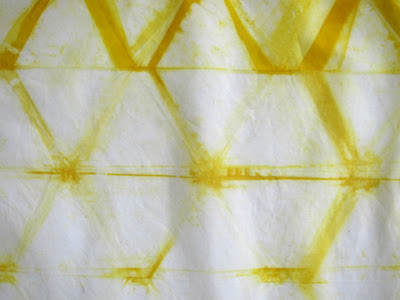
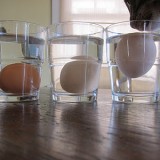
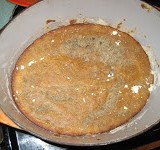
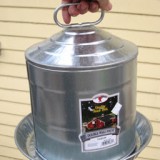
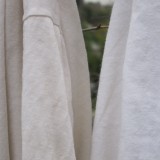
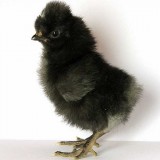
Cool – good to know it works on brown eggs as they are the only ones available in our local stores. Hmmmm, I wonder why white eggshells aren’t produced anymore…?
Could it be to do with their diet?
Brown eggs dye differently, of course, and only in dark shades, but yes, it works.
Egg color is a factor of hen breed, not diet. I think in public perception brown eggs are considered more natural or desirable than white (though they are actually nutritionally identical and the hens are raised the same) — but that perception might bias store buyers. ??? I still see lots of white eggs on the shelves here, in LA, for what it’s worth.
I don’t think it’s the bloom issue, as we just dyed some eggs quite successfully with no pre-washing. Although that was with non-organic dyes, so maybe the craft-store dyes deal with egg-bloom better than natural dyes?
(I learned when we moved here from California that it’s illegal to wash eggs before sale in the UK, which makes SO much sense – they last longer, don’t need to be refrigerated, and I can’t even imagine how much water is saved. There’s a campaign for someone to start in the US – Ban Egg Washing!)
Interesting! And re: the washing — interesting, too! If washing were banned in the US, then for the sake of public health the factory hens would actually have to be provided with clean nesting boxes. Radical!
The slimeyness was probabably because of the vinegar starting to dissolve the shell. If you leave an egg in vinegar for a day or so it will dissolve the shell entirely. 🙁
Ah! Maybe I added too much vinegar? The recipe was a little vague, but it did call for a long soak, regardless. Maybe it would be better just to boil the eggs in hot, freshly made dye, using heat to make the process shorter.
You might like this post on fermented/decorative eggs. I might give this technique a try next year. http://phickle.com/index.php/decorative-pickled-eggs/
Beautiful. I LOVE the finished eggs!
I had this problem too, when I attempted to dye my own eggs a couple of years ago with onion skins. I’ll link to my post here: http://400squareftliving.blogspot.ca/2012/03/easter-display.html
Do you mean you boiled your eggs in the organic matter and vinegar for the color? I have several shades of brown eggs. Each hen has her own shade. Of course, since I only have two laying hens right now, I have two shades and two size eggs. I just dye eggs in the dye from the store, using the vinegar it calls for. About thirty minutes is the longest I have left eggs in the dye.
I never wash the bloom from the egg before I boil them or dye them.
If anyone worries about the brown eggs not taking dye for a true color, there is a darker shade of dye. But, I forgot how they designate this on the package.
I always buy Easter Egg color when it goes to about ten-cents for a box. At that price, I no longer use the food dye in a bottle even though I have it in the cabinet, some over 20 years old. I also mail the dye kits to my children after Christmas along with a birthday gift.
The long soak in vinegar is most likely responsible for the slime and dissolving of the shell like someone said.
On a friend’s advice, I used turmeric for yellow and blueberries for blue. They seemed to work fine with no vinegar at all — just water + dyestuff. The beets, sadly, did not work so well this time. Maybe next year.
My grandmother would dye all her Easter eggs with red or yellow onion skins, and they were beautiful shades of sienna red. These eggs came delivered to her Baltimore home by a farmer, but I’m sure they were thoroughly washed beforehand. This year, rather than dyeing eggs, we purchased Araucana eggs at our local farmers market, in lovely shades of green and blue.
Your eggs look beautiful! I have 1 &3 year old kids so I purchase white eggs that go on sale and use regular cheap Easter egg dye. I have blue egg laying chickens and worry that the difference in color would be confusing or stifle some creativity. but if the bloom does interfere with the dye I imagine very creative egg dying experiments in Easters to come! I looked at all the natural dying projects with envy the past few years but felt it would be in vain. most of our eggs come out olive green after my son tries to dip his eggs in each color. But the important thing is we still have fun.
I would say part of the problem you had is with the dye stuff. Red cabbage will dye blue, but it’s pretty fugitive, as are beets, which someone else mentioned. I tried hibiscus flowers for dye on wool, and it was a disappointment, just a dull beige. And it was a gooey slimy stuff after soaking the flowers.
A friend showed me how to dye eggs with onion skins successfully. She would place little flowers or plant matter on the egg (as a resist), then she wrapped the eggs in onion skins, tied them up to hold the skins in place and boiled. The eggs were a dark russet color with white areas from the flowers, grass, etc. I don’t know how long she boiled them. Certainly worth trying. I don’t remember using any vinegar.
I also dye wool. Carrot tops make a nice pale yellow with a hint of green. Fennel should be similar, but I haven’t had great luck with it. Purple basil can be used as a dye too, but I haven’t had great luck with it either. It’s easy to get an assortment of yellow and beige colors with plant material. Red onion skins are supposed to dye green with the addition of alum – but it’s never worked for me either.
Thanks! I’ve wanted to try the resist method with onion skins. Next time I’ll just skip the vinegar.
Oh, and interesting about the hibiscus and slime. I guess it’s thing. Some hidden mucilaginous property? To be fair to the post I was following, they didn’t suggest hibiscus, I just thought it would have strong dyeing properties. The color it made was sort of a nice purplish grey.
I have used natural egg dye for years and would agree that the troubles were likely with the vinegar and not the dye materials. Here’s a link to the recipe I use: http://www.mnlocavore.com/2011/04/natural-easter-eggs/
Thanks!
those eggs look awesome!!! like dragon eggs:) hopefully i will try some natural egg dyes next year, these would be cool props for a Game of Thrones party!
Dear Mrs. Homegrown!
Last night I stumbled upon your site, but was too tired to write an answer. Tonight I am a bit better, so here is a few words on how we make easter eggs in my country – Slovenia.
Actually Slovenia is a haven for easter eggs. Each part of the country has a different way of decorating them and therefore has a different name – pirhi, pisanice, remenke, drsanke, … One of the most famous ones come from Bela Krajina and are made either by scraping away layers of pain or drawing a pattern with wax and then dying the eggs in different colours (you can see a video here – http://www.siol.net/novice/rubrikon/fotofokus/2012/04/fotofokus_pisanice_in_drsanke.aspx).
Although this is a very beautiful tradition only a few people have the skills required to pull it off.
So for the rest of us it is either store-bought dyes or using natural materials such as onion skins, beetroot, grape juice, rosehip tea, wine, turmeric, spinach, dandelions, nettles, red cabbage, …
Especially onion skins are very popular and are very easy to master – but you need to be very good and gather your onion skins all through the year, so you have enough material to work with. I find that a mix of yellow and red onion skins works best, but only yellow are ok too. Just don’t use only red skins, because they tend to turn the eggs grey.
And you will also need some pantyhose (can be old, torn ones; cut into approximetely 3×3 inch squares) and some leaves or flowers – the more “feathery” the better.
It is best to start the night before. You start with RAW eggs. Place a leaf / flower onto an egg and wrap it in a piece of pantyhose, tie with string. Repeat the process with all of the eggs.
Then put a generous layer of onion skins on the bottom of a large pan, place the eggs on top and cover with more onion skins. Pour enough cold water to cover everything and leave at room temperature overnight. You can add some salt to prevent cracking, but vinegar is not required.
In the morning bring the eggs SLOWLY (this is important, as it helps to reduce cracking – took me a while to figure it out) to boiling and cook for 5-7 minutes. Remove them from heat and let them cool in the onion-coloured water. When they are cool, remove the pantyhose and VOILA!! You have some beautiful easter eggs Slovenia-style. 🙂
For some extra shine you can rub them with a piece of bacon.
I would love to post a picture of my last year’s success, but haven’t figured out how. :-S
Well, it was a bit more than a few words, but I hope you survived.
Wishing you all the best,
Urša from Slovenia
Thank you very much! Wow! Slovenian wisdom!
They are BEAUTIFUL!!! So grateful for all of your brave experiments — you two!
Not sure its the bloom that caused the funkiness. We lived on a biodynamic farm commune for several years and never washed our eggs. All the children of the community used those eggs for dyeing with great results. We also used onion skins, turmeric, cabbage leaves, etc. I’m thinking it was the vinegar soak. Thanks for sharing!!
Yep, from the other comments I think it was the vinegar too. Next time I’ll try it w/o the vinegar and post back.
Re: Egg washing:
“As the eggs are scrubbed, rinsed, dried, and spritzed with a chlorine mist, its protective cuticle may be compromised. This is a natural barrier that comes from the mother hen that lays the egg, and it acts as a shield against bacteria.”
http://articles.mercola.com/sites/articles/archive/2013/12/07/refrigerating-chicken-eggs.aspx